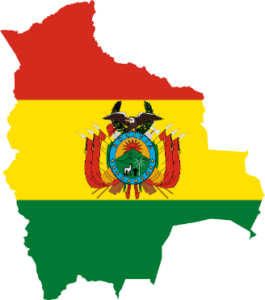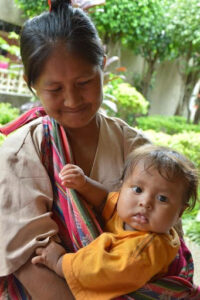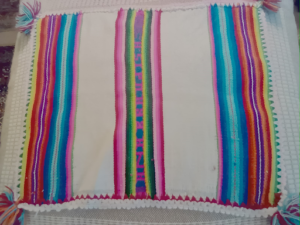“We experience a sense that there are possibilities that are better than what we are and have been.”1
When I was a child, after supper my father liked to open his World Atlas, and, sitting around the kitchen table of our small house, my brothers and I would pinpoint a country we wanted to look up and find out about. In those days, since geography was my favorite subject, I was very content with these family explorations.
For some reason, among the many countries we looked up, I never forgot certain details about the county of Bolivia. I remembered that Lake Titicaca was the World’s highest navigable lake. I remembered that Aymara was the language of the people who lived on the shores of the lake, and how the women dressed and carried their babies on their backs.
Bolivia
Later, I learned of the steep trails of the Andes Mountains and the remote villages of Quechua People who lived there with their flocks of sheep and llamas. I learned of the tropical lowlands of the Beni stretching into Brazil with their settlements accessible only by way of tributaries of the mighty Amazon River.
Recently, influenced by the life and work of the quantum physicist David Bohm, I have been looking at events and patterns that seem to have been present in my life from childhood and which are still today unfolding in their meaning. Where I previously shied away from dwelling on the past, I now am seeing that the past is very much present and still happening. Better said, it appears that meaning from past events is not only available and retrievable as memories but in reality happening now. Perhaps I have always known this but never consciously considered it.
The country of Bolivia and my experiences related to it are uppermost on my mind. In this post I will explore one of these experiences in view of what I am learning as I study the ideas of Bohm and the developing Holomovement, which he originally named.
As a young adult I always held a deep interest in lands and people beyond my own. This interest, I found, could not be satisfied by tourism. It was, then, without hesitation that I responded to the opportunity to work in Bolivia, where I ultimately remained for fifteen years. These were incredible years with the richest of cultural experiences among the Aymara and Quechua Peoples as well as briefly with the people of the Beni, close to Brazil.
I spoke Spanish well enough, however, while Spanish was the language of the State, it was not the language of the ordinary people. The people used multiple languages, which had no roots in Latin or European based languages. Ordinarily these languages were very challenging for foreigners to learn. This was certainly true for me. Beyond the most elementary of conversations required continuous study and practice.
Academically speaking, I knew that language carries culture. Knowing this was good motivation for persevering in the hard work of language learning. Reflecting back though, I did not know deeply what that meant. I considered it important to both know and respect how the people thought. What I missed was personally knowing as they know.
Most of my years were spent among the Indigenous Quechua speaking people living deep in the Andes.
Aside from the challenge of language and culture learning, it took me a long time to recognize and undo an assumption that was as natural to me as breathing: I thought that as Americans we had reached a civilizational pinnacle. On top of my natural interest in cultures, I was also motivated by wanting to share developmental ideas and means toward a better life as perceived within the Western Worldview. I shudder now to think of how limited my thinking was. I did not even know then that there were other worldviews or valid ways of grasping the nature of the Cosmos and one’s role and place in it. Much less did I understand how much I was influenced by materialism.
I certainly did not then frame my overarching perceptions as flowing from a materialistic society. It is always complex to look at this, especially because this same society obviously has provided benefits that are good for humanity, particularly health and medical benefits, and the elimination of terrible diseases. The problem, as I see it, stems from limited philosophical understanding.
These were the same years that found Bohm standing back from scientific orthodoxy, observing its deadening effect on society, the loss of meaning and expansiveness, and how it limited the knowledge of how the world works to only what could be observed and measured. Bohm did not vilify scientific processes, rather he grasped more than what they could measure or determine. He found himself plunging into, and systematically studying, spiritual and religious experiences and beliefs as passed down through ancient traditions, including the traditions of Indigenous People. He paid attention to what he felt. He sensed there to be a unified field beneath all that emerges and that is consciously known. He called it the Implicate Order. This is what brings forth the emerging evolutionary world and all potential while at the same time sustaining the physical and cosmological order that all generations of people trust as the background of their lives.
Indeed, Bohm took his brilliant mind and honest character to every field he explored.
He was captivated by language and the possibility that all ways of communicating and perceiving are available to newly forming humans still within the womb. He saw that the structure of spoken language influences perceptions.
In view of this, during the past summer I attended a riveting Zoom conference entitled Beyond Bohm: an order between and beyond, by David Schrum, PhD, sponsored by the Pari Center, in Italy. One of my learnings from this conference is the importance and significance of being attuned to what is transpiring. Related to this, I was reminded of an experience while living among the Quechuas years ago that changed me profoundly. I think this happened because I was committed to understanding their culture and speak their language. For example, as often happened in this culture, I was invited to a distant village to participate in its annual fiesta. On the eve of the fiesta, I set out in the early morning hiking part way and mounted on horseback part way, arriving in the village around three in the afternoon. The people who belonged to the village were also arriving from their plots of land which were scattered throughout the hillsides. The atmosphere was joyful and celebratory. We gathered together and I was invited to speak. Afterward, they served me a big meal and others joined in to talk and make various arrangements for the event. By dark, they showed me where I would spend the night, though I knew that they would be up until dawn lost in their traditional preparations for the next day.
Earlier, they were very proud to show me a simple and quite precious chapel they had built. Never having intruded beyond what the people invited me to participate in in the past, I felt compelled that evening to wend my way back to the chapel, which I could see was bright with light from candles and small oil lamps. I went inside and sat down on the dirt floor just inside the door. There were many people there, all engaged with the Holy in their own way. I was taken by one woman in particular, so concentrated was her prayer. I felt unusually connected to her.
While I’m sure there was present some influence from the European missionaries of years long past, I was transported into a mode of spiritual experience that seemed to predate foreign influences. I was consumed! What has stayed with me all these years since then is the undeniable memory of knowing the Sacred in and through the way of these people. This was not a temporary alteration after which I returned to my usual way of being. Interiorly, I was changed and set on a path that I could not have known otherwise.
This was the most expansive experience of my life. It immediately opened me to seeing the limitlessness of the Sacred beyond all prescriptions, and prepared the way for what I have come to identify in later years as the interconnected whole described by Bohm. This did not come to me so much through the Quechua language as through the attunement that came to me through what the language opened up, even if not entirely grasped.
Since then, I see differently in terms of worldview, and I know differently. Perhaps most importantly, I cannot separate these bedrock life experiences from a perception of purpose or calling running through my life. This has come to include offering some form of healing as service to people or to the Earth itself, as I’ll explore in another post.
Bolivia is always present as a thread running back and forth in my life, always tending toward potential yet unrealized.
Keepsake of woven fabric from Bolivia
1 The Holomovement: Embracing Our Collective Purpose to Unite Humanity, Light on Light Press, 2023, Edited by Emanuel Kuntzelman & Jill Robinson, p. 54.




0 Comments